Visual thinking for muggles
Salvador Valle is head of user experience at BBVA Next Technologies, where he researches on new interaction models. In this article, he explains some basic concepts to get started in the world of visual thinking, and making the most of these sketching techniques to explain and disseminate ideas.

My name is Salvador Valle and I’m head of user experience at BBVA Next Technologies. Although, maybe a better way to introduce myself would have been: “Hello, my name is Salva and I am a muggle.”
In the Harry Potter saga, a muggle is a non-magical person. But, why do I say that I’m a muggle? The answer is that I don’t know how to draw. I lack this talent, this ‘bit of magic’ that distinguishes those who are capable of conveying into paper what’s in their head from those who aren’t.
Anyone who hasn’t been graced with this gift knows how frustrating facing this challenge can be. But, while we may never build the skills to become wizards, we all can become what ‘are known as half-bloods in the Potterverse, a mix between muggle and wizard.
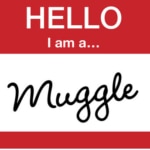
All it takes is to learn a few basic skills first. Indeed, to be able to work visual thinking’s magic, we all need to master certain powers that will help us in our day to day work.
What is visual thinking for?
Visual thinking is a very useful way of conveying information, even complex messages, using drawings or graphic resources. Visualizing our ideas to understand them better is possible thanks to the use of visual thinking tools in four large areas.
The first one is ‘visual management’. These are the boards that help us group ideas and are key to developing projects, products and services. The second one is ‘sketchnoting’, your visual notes and annotations. They are extremely personal and help you focus, understand concepts and distill them.
It’s in line with the next tool: ‘graphic facilitation’. This tool allows synthesizing ideas, remembering the key points to improve learning, decision making and group dynamics processes. Finally, ‘graphic recording’ entails drawing the essential information in real time during events, meetings and courses to promote group memory and motivation.
And last but not least: the ‘wand’ to make things happen. Just as each wizard has his/her own wand, markers are the quintessential visual thinking tools. I, of course, have my favorites. But if you still are not sure which one is right for you, I would recommend using markers that flow evenly and dry fast, preventing colors from leak through the page and mixing when coloring.
But, regardless of how good the wand is, without spells and potions, magic will not happen. To harness the power of visual thinking, you don’t need to be a proficient artist. All you need is to be master a few tricks:
1. Open shapes, closed shapes
The most-basic geometric forms are our perfect ally to start. You don’t need to know how to draw; you can render complex objects, ideas and concepts through geometric synthesis: In other words, using closed shapes such as the square, the circle, the oval, the rectangle, the triangle, the rhombus and the trapezoid. There’s no reason for not keeping things simple. The same goes for open shapes: lines, architectures, waves, spirals and the broken lines.
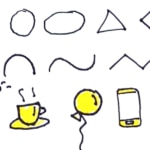
2. From big to small, and then, the details
This will be our drawing order: first draw the biggest shape and then work your way down to the details.
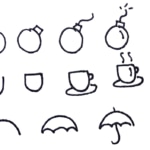
3. Content, context, design
This is very important. To draw something, first we need to decide what we want to represent, then what meaning we want to convey through it, or the context, and then we can already start drawing it.
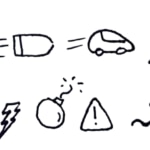
4. Drawing in front-to-back order
This part is especially hard for muggles, but getting used to drawing always first what’s closer and then work on the background elements is essential.
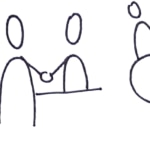
5. Drawing people
Including people to your sketches adds a lot of power to your creations. Drawing people is not that hard using the basic shapes we mentioned above. circles, triangles, squares, rectangles, lines…
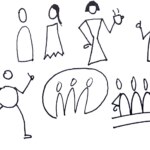
6. Arrows and processes
Arrows are extremely useful elements to represent flows, so don’t forget to use them to make your drawings more meaningful. Keep your sketches as simple as possible. It will make them much easier to understand.
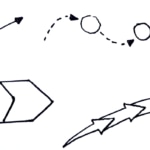
7. Include text to read
Visual thinking is not about sketching only. But, it is extremely important that the text you include is legible. So, mind your calligraphy and use different styles when writing titles, highlights and normal text.
8. Details, last but not least
Even though you’ll be adding them at the end, details are very important. A bomb or a bomb about to explode, a cup or a cup filled with some hot concoction, a car or a speeding car… small details can make a big difference.
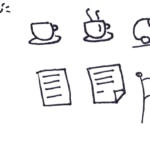
These seven basic tricks should help you get started, but there are many more. Too many to fit into one article. What can you do? Just practice and you’ll see how your visual thinking powers start flowing naturally.
These are the powers you build
With a bit of practice, some of the powers of visual thinking will soon start showing, and you will be able to focus, research and understand concepts better. Because thinking in terms of key ideas will boost your ability to synthesize and structure content, and your creativity. Visual thinking nurtures aesthetic emotion and increases motivation, which is essential to accomplish our goals. Keep practicing every day and you’ll see how much you improve in a very short period of time.
Finally, here’s a sample taken from my notebook, to illustrate how a muggle like me has used visual thinking to improve the way he works.

Ejercicio de 'visual thinking' - Salvador Valle